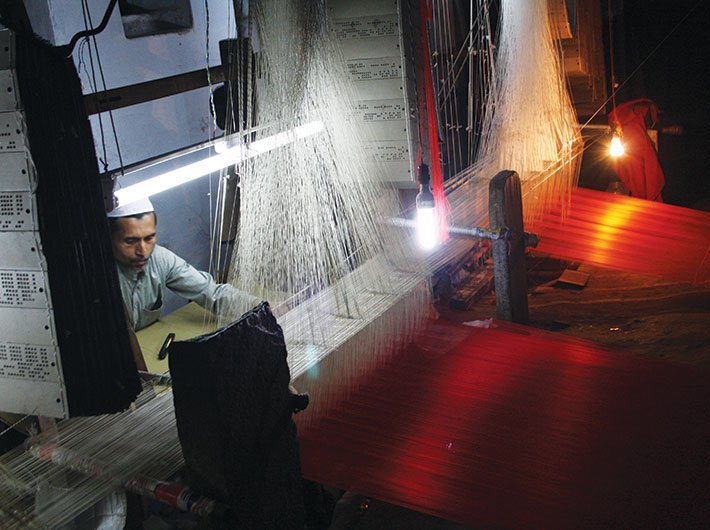In the land of weaver-poet Kabir, good days haven’t come back yet for the hands weaving silk threads
The call of the muezzin and chiming temple bells break the stillness of air over Ganga as Rehaan Hasan wakes up for the day. Now in his sixties – he does not know his exact age – Rehaan remembers waking up at his Sesman Bazar home to these familiar sounds of Varanasi since the age of 10.
Passing through the Bazar one can hear the rhythmic clatter of thousands of looms; thousands of deft hands are weaving the warp and weft even in the darkness.
Rehaan’s two-room tenement is in a thickly populated quarter of the ancient city. Here, houses are stacked against each other; narrow lanes offer passage to just one person at a time; pet goats and stray dogs loiter around. This is one of the scores of weavers’ pockets – mostly inhabited by Muslims – in the city that lends its name to the art of fine weaving of Banarasi silk that, of late, is making waves in the international fashion world.
But Rehaan, who heads a family of 13, is oblivious of the global fashion trends. As the handlooms were shutting, he and his brother recently bought a power loom for Rs 1.5 lakh – their life savings – with the hope that it will be a turning point in their lives. The new loom, they thought, would make their seven-generation-old profession of silk weaving lucrative.

Every morning, after offering his prayers, Rehaan wraps two chapatis cooked overnight in a newspaper and sets off to his elder brother Noor-ul-Hasan’s house where he has set up the new machine. His own home was too small to house the giant power loom. On the way, as he walks past the dusty and cramped lanes of Sesman Bazar, he feeds bread crumbs to dogs and goats. Also, he continues to do mental calculation of the money he would earn by working for 15-18 hours that day.
The entrance to Noor’s house is narrow and there is no gate. The family had been, for a long time, planning to put up a door with some savings.
Rehaan and his brother together are able to weave one saree per day; it sells for about Rs 3,000-5,000 in a shop. However, the brothers are paid only Rs 500; bulk of the profit is gobbled by the gaddidar (the wholesaler who acts as a middleman) and grihasta (master weaver who gives them business).
Like other weavers who form the bottom line of the multi-crore Banarasi saree business, the brothers procure raw materials from middlemen. The latter buy back the stuff for Rs 22 per metre. Interestingly, a middleman is most often a grihasta, who has graduated from producing to trading. He is a man of means and makes huge profits by outsourcing production for his bulk orders to people like Rehaan.

While showing me around Rehaan tells me that seven generations of his family had mastered the art of fine weaving by working on intricate brocades and famous cotton and katan silk of Banaras; but today, he and his brother feel like bonded labourers.
He takes us to the next room where he occasionally works on his handloom – the wooden contraption lay sunk in a 1.5 ft pit; a faint yellow bulb hanging over it. For weaving, he sits on the edge of the pit with legs hanging. He rubs the spindle (used for wrapping the weft) with one hand and feels the silk cloth with another.
Contrary to their expectations, the power loom hasn’t changed their lives. Earlier they would weave a handloom saree in a month and earn about Rs 1,000. Now, Rs 250 per day looks better but given their investment and expenses on power and maintenance of the machine, it is not a dramatic change.
There are reasons for this. Firstly, a weaver’s product does not carry a fixed price. Secondly, a weaver has no direct access to the buyers – the end user. Also, he has no clue about the markets. “I always feel cheated but have no option other than continuing to work for middlemen,” he says.
Occasionally, when Rehaan had taken the risk of working independently, he would buy his yarn, dyes and other raw materials from the market. After weaving a saree, he again had to approach a middleman to sell it. Only this time, margins are slightly higher. Like Rehaan, most of the weavers are poor and hence end up working under the bani (contract) system.
So, it is the middleman who decides the fate of weavers like Rehaan and Noor. “If they don’t give us work, we would starve,” says Rehaan. Also, weavers cannot think of getting out of the business since their money is stuck in the system. Rehaan says he has been paid for 10 of the 24 sarees he had woven during the past few months. As the trade works on understanding and relationships and there are no account books, Rehaan has nowhere to go in case he is not paid his due.

At times traders return a saree saying that it did not sell and he would not be paid for this. However, a weaver continues to work in the hope that one day he will get his dues. “I can’t go to other traders as loyalty is valued,” says Rehaan as he throws the spindle from left to right over the warp on the handloom. He admits that he was touching the old loom after a year.
Far from the glamorous world of fashion and models sashaying in Banarasi silk drapes in big cities, thousands of weavers in Varanasi see the looms as harbingers of poverty. In many homes, handlooms have made way for the noisy power looms. “While handloom is the original art, power loom is a volume game,” says 40-year-old Muharram Ali, another weaver in the locality. He explains that every handloom weaver is a power loom convert, either using all his savings or taken a loan from money lenders or gaddidar to set up the loom.
Quest of a genuine weaver
After meeting Rehaan, I am left wondering who is being helped by the plethora of schemes that the government has launched for weavers and handlooms. As it happens in other state-run schemes, here too, the benefits, it seems, have not percolated to those at the bottom.
As I am trying to delve into the lives of Rehaan and Ali, suddenly, the yellow bulb over another handloom comes live. Noor-ul-Hasan, who had kept mumbling as we were talking, is ready to work on the loom. Gazing at the golden motifs he had woven on blue silk threads, he remarks: “Who is a weaver? A person who left weaving and became a rickshaw puller, or the one who has a weavers’ identity card but is a trader?”
Noor’s questions are loaded with answers.
According to the handloom census 2009-2010 [the only headcount of weavers available], 61 percent of the handloom weavers work independently and 39 percent are hired by traders or middlemen or institutions like Khadi Village Industries Commission, etc.
KP Verma, deputy commissioner, handloom, Uttar Pradesh, says that selling Banarasi fabric requires a complex network. “A weaver alone cannot do the weaving and marketing too. But, yes, some progressive weavers are doing this,” he says.
Silent handlooms
Banaras was a prominent centre of weaving cotton clothes centuries ago. A turnaround came in the 14th century, when the Mughals patronised highly skilled artisans and craftsmen. They weaved zari and brocade designs using gold and silver threads, which till now remains a specialty of the region.

However, in the 1990s, the Banarasi saree industry faced a crisis when power looms became commonplace, and suddenly the handlooms were shutting. This difficult period saw a flight of many weavers to Surat and Mumbai. However, when things started looking up with the industry reconciling to power looms, suddenly the demand for silk, yarn and dying units increased. Varanasi, by no means, was ready for this.
“When Modi came to power, we expected him to address our basic problems – easy availability of silk, yarn, designs and dying units. Without addressing these, no amount of money or investments would help us,” says 21-year-old Jabiullah, another weaver in the area. He regrets not having completed his schooling. “Had I done it, I would not have to sit at a loom. I could be doing some better work,” he says.
Jabiullah laughs off the government’s e-retail initiative for weavers to sell their produce. “It is like telling a farmer living in a remote village to sell crops online!”, he remarks.
People like Jabiullah are in weaving against their wishes. It’s difficult for him to get a job in the industry since he is not trained in anything else. It’s clear that the younger lot of weavers do not have a sense of ownership in the sector.
According to handloom weavers’ census, the Varanasi region, comprising districts of Varanasi, Chandauli, Jaunpur, Mirzapur and Bhadohi, has 45,928 household handlooms employing 95,439 weavers. This is a clear anomaly given the fact that in reality there are around three lakh weavers including women.
“The official headcount relates to the number of identity cards issued by the government, but there are many skilled weavers who don’t have an identity card but have been weaving since generations. Besides, women and children of the weavers families are also engaged in thread cutting, zari and stone works. These people are not counted anywhere,” says Ali.
For weavers, Narendra Modi’s promise to help them, as part of his election campaign, had given new hopes. After becoming prime minister, Modi had announced a Rs 147 crore trade facilitation centre and a crafts museum for weavers on the outskirts of Varanasi. Works on the two projects have just begun though weavers don’t have high hopes from them.
Real versus fake
Now the Varanasi handloom weavers are facing a serious threat from fake ‘Banarasi’ products mass-produced in Surat and China. Obviously, the fakes come at a lower price and the gullible buyer falls for these over the real ones.
To counter the fakes, the weaver associations in UP had got a geographical indicator (GI) tag for ‘Banaras Brocades and Sarees’ in 2009. This would enable a discerning buyer to identify a genuine product from a fake one.
Later, the government had launched the ‘India Handloom’ brand for quality control. Interestingly, in Varanasi region, which is the largest handloom cluster in the country, only six weavers have so far registered under the brand. Similarly, despite the paltry registration fee of Rs 25 for getting Handloom Mark (an initiative introduced by the UPA in 2006), not many have acquired it. No Varanasi-based exporter has used this tag so far.
Rajnikant of Human Welfare Association, who has been working for the cause of weavers and artisans, says, “The plight of handloom weavers will not improve unless they are made aware of the importance of ‘India Handloom’ brand, GI tag and Handloom Mark: all three authenticate the woven material.
“Lack of an authentication mark adds to their troubles. Even if the poor weaver has woven an authentic product, his claim about the originality of the product will not be trusted by big entrepreneurs and traders. This was the major reason why e-retailing failed,” says Rajnikant adding that the Banaras silk industry has an annual turnover between Rs 800 crore to Rs 1,000 crore.
Noor has been weaving the golden brocade on the blue silk all through our conversation at his home. He suddenly asks, “One might wonder, as to where does all the money go?”
[email protected]
(The story appears in the April 1-15, 2016 issue)

